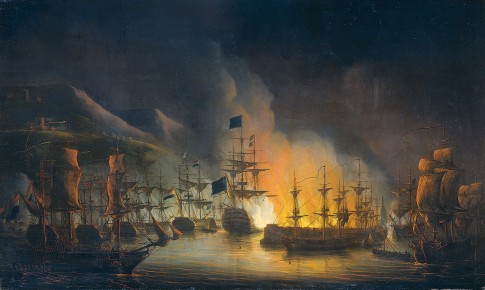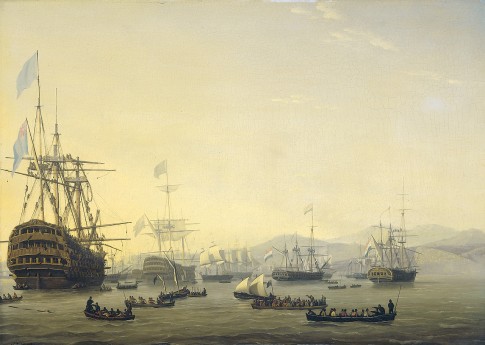
Bombardment of Algiers, to Support the Ultimatum to Release White Slaves, August 26-27 1816, painted in 1823 by Martinus Schouman on orders of Ministerie van Marine
Rijksmuseum Amsterdam
These two paintings depict episodes of a joint Anglo-Dutch action against Barbary States in 1816. For centuries the forces of North African monarchies have been raiding the shores of Christian Europe capturing fishermen, looting coastal villages and town; sometimes reaching as far as to England, Ireland and even Iceland. Slaves were captured to be sold on markets in Algiers and Tunisia. European maritime powers responded with punitive expeditions but did not completely succeed to stop the slave trade in North Africa until the French colonization in mid. 19th century.
One of such expeditions took place in summer of 1816. Following the end of Napoleonic Wars England no longer depended on supplies purchased in Algiers for her Mediterranean Fleet. Besides there was considerable political support for action against Barbary pirates and slavers. In 1816 a squadron led by Admiral Sir Edward Pellew, 1st Viscount Exmouth managed to convince Dey of Algiers to sign a treaty to stop the white slave trade. However, due to misread orders Algerian troops massacred Sicilian and Corsican fishermen who were under British protection. This caused an outrage in England and elsewhere in Europe, and Admiral Pellew was ordered to punish the Algerians.
In August 1816 a squadron of five ships of the line, one 50-gun ship and four frigates sailed out and was joined in Gibraltar by a Dutch force of five frigates and a corvette commanded by Vice-Admiral Theodorus Frederik van Capellen.
Algiers was well defended by shore batteries whose destruction was to be the first objective for the allies. Algerians planned to let the enemy ship close to the mole without firing at them and then to border them with large number of men in small boats.
On August 27 1816 the allied force reached Algiers. The action started at 3:15PM when due to the lack of discipline one Algerian cannon fired a shot at the British ships. This was immediately answered with a hail of fire. Algerian boarding attempt failed and 33 of their boats were sunk. By 7:30PM most of the coastal artillery was silenced and the Allies started firing at the shipping in the port. At 8:00PM a British bomb vessel exploded following a navigational error when trying to bear its guns against a shore battery. The action was over when at 10:15PM the British weighed anchor and sailed away. HMS Minden kept suppressive fire until 1:30AM and by this time the allied squadron anchored out of range.
The action was intense and the British had 818 men killed and wounded 16% casualties. Algerians reportedly lost around 7000 men.
The following day Pellew sent a peace offer threatening to continue bombardment. This was a bluff as the British were almost out of ammunition. The Dey, however, accepted the terms and freed 1083 Christian slaves and repaid the ransom money.
Council of War Aboard the Queen Charlotte Held by Lord of Exmouth before the Bombardment of Algiers, August 26, 1816, by Nicolaas Baur 1848.
Rijksmuseum Amsterdam
Special thanks for the idea and materials for this post to Edwin from Holland
